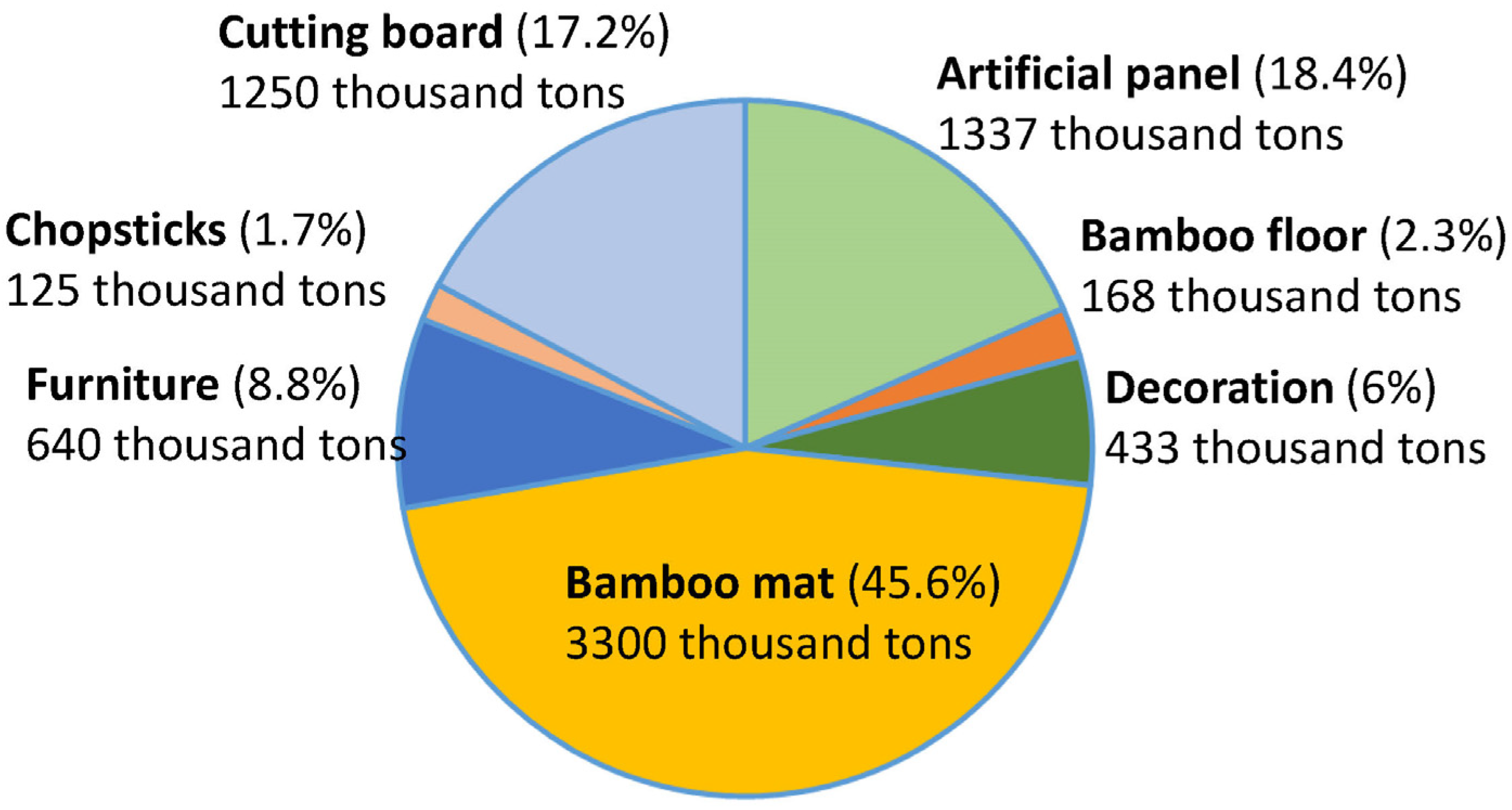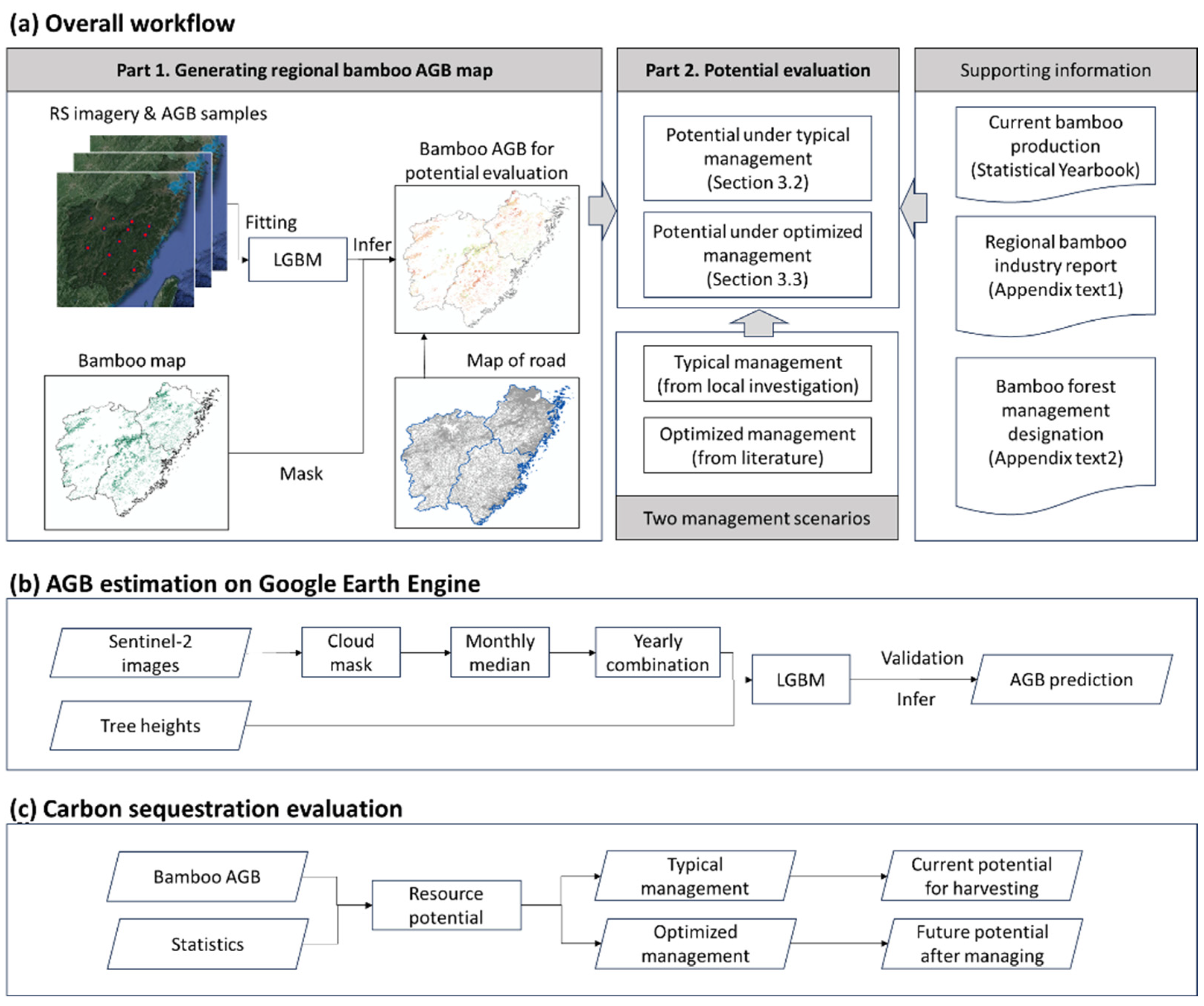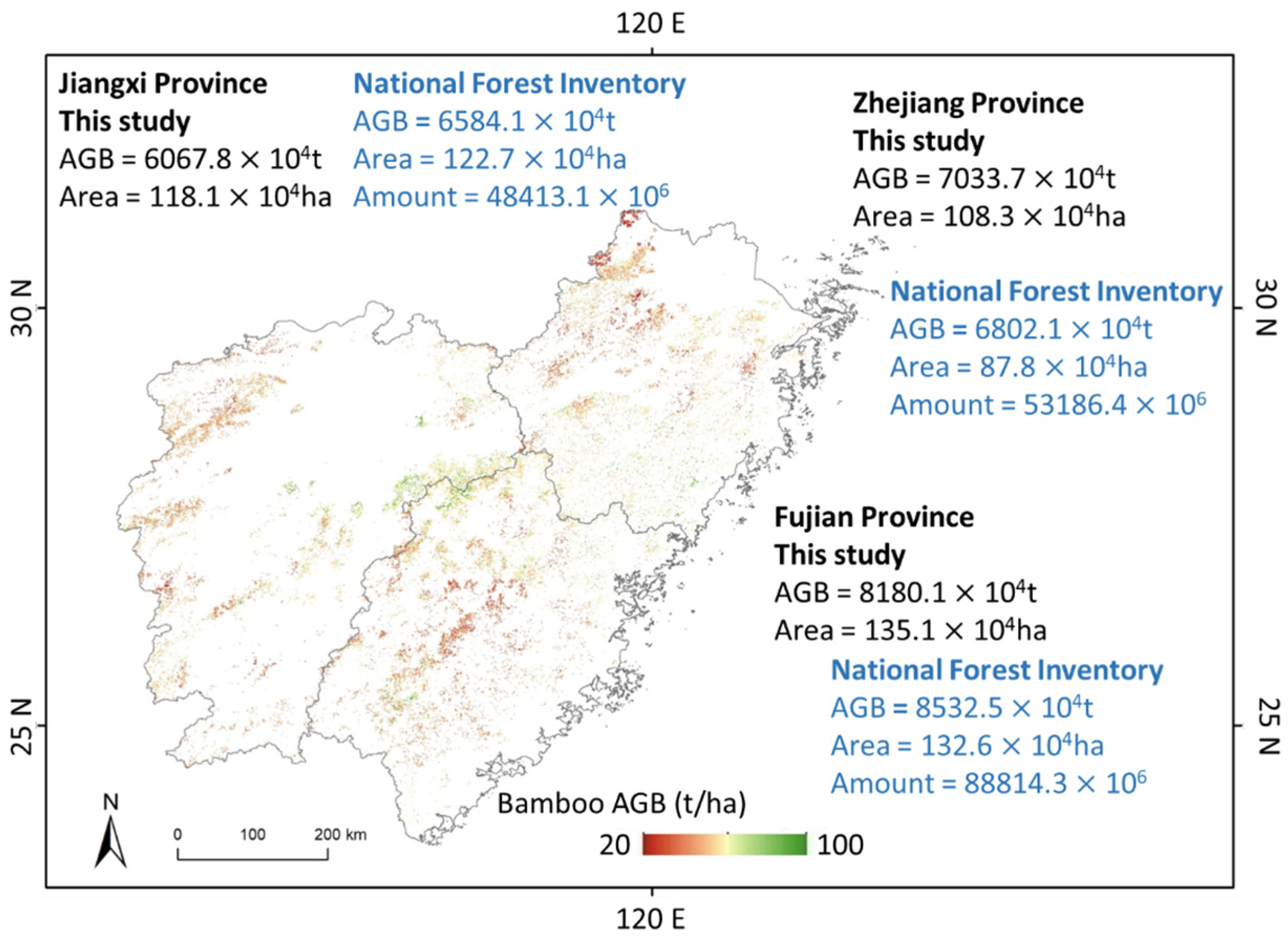Bamboo Forests: Unleashing the Potential for Carbon Abatement and Local Income Improvements
Abstract
:1. Introduction
2. Materials and Methods
2.1. Study Area
2.2. Data
2.2.1. Spatial Data
2.2.2. Non-Spatial Data
2.3. Method
2.3.1. Bamboo AGB Estimation
2.3.2. Potential in Reducing CO2
2.3.3. Potential for Improving Local Income
2.3.4. Management Scenarios
3. Results
3.1. Bamboo AGB
3.2. Bamboo Potential Under the Typical Management Scenario
3.3. Bamboo Potential Under an Optimized Management Scenario
4. Discussion
5. Conclusions
Author Contributions
Funding
Data Availability Statement
Conflicts of Interest
Appendix A. An Excerpt from the Investigation Report on the Zhejiang and Anji Bamboo Industry
| All Enterprises | Small and Micro Enterprises | Medium Enterprises | Large Enterprises | |||||
|---|---|---|---|---|---|---|---|---|
| Amount | Proportion | Amount | Proportion | Amount | Proportion | Amount | Proportion | |
| Zhejiang | 4011 | 20.30% | 3700 | 20.18% | 300 | 22.73% | 9 | 11.39% |
| Fujian | 2151 | 10.89% | 1575 | 8.59% | 559 | 42.35% | 13 | 16.46% |
| Jiangxi | 524 | 2.65% | 493 | 2.69% | 24 | 1.82% | 1 | 1.27% |
| Region | 2019 | 2020 | 2021 |
|---|---|---|---|
| Anji (Local) | 450 | 440 | 410 |
| Other regions of Zhejiang | 440 | 440 | 460 |
| Fujian | 500 | 550 | 580 |
| Jiangxi | 470 | 480 | 490 |
| Other provinces | 450 | 446 | 453 |

Appendix B. Investigation Report for the Bamboo Management Strategies
References
- Feng, X.; Tan, S.; Dong, Y.; Zhang, X.; Xu, J.; Zhong, L.; Yu, L. Mapping large-scale bamboo forest based on phenology and morphology features. Remote Sens. 2023, 15, 515. [Google Scholar] [CrossRef]
- Liese, W.; Kohl, M. Bamboo. The Plant and Its Uses; Springer: Cham, Switzerland, 2015. [Google Scholar]
- Li, Y.; Feng, P. Bamboo resources in China based on the ninth national forest inventory data. World Bamboo Ratt. 2019, 17, 45–48. [Google Scholar]
- Qi, S.; Song, B.; Liu, C.; Gong, P.; Luo, J.; Zhang, M.; Xiong, T. Bamboo forest mapping in China using the dense Landsat 8 image archive and Google Earth Engine. Remote Sens. 2022, 14, 762. [Google Scholar] [CrossRef]
- Dwivedi, A.K.; Kumar, A.; Baredar, P.; Prakash, O. Bamboo as a complementary crop to address climate change and livelihoods–Insights from India. For. Policy Econ. 2019, 102, 66–74. [Google Scholar] [CrossRef]
- Jian, J.; Jiang, H.; Zhou, G.; Jiang, Z.; Yu, S.; Peng, S.; Liu, S.; Wang, J. Mapping the vegetation changes in giant panda habitat using Landsat remotely sensed data. Int. J. Remote Sens. 2011, 32, 1339–1356. [Google Scholar] [CrossRef]
- Bal, L.M.; Singhal, P.; Satya, S.; Naik, S.; Kar, A. Bamboo shoot preservation for enhancing its business potential and local economy: A review. Crit. Rev. Food Sci. Nutr. 2012, 52, 804–814. [Google Scholar] [CrossRef]
- Manandhar, R.; Kim, J.-H.; Kim, J.-T. Environmental, social and economic sustainability of bamboo and bamboo-based construction materials in buildings. J. Asian Archit. Build. Eng. 2019, 18, 49–59. [Google Scholar] [CrossRef]
- Singhal, P.; Satya, S.; Sudhakar, P. Antioxidant and pharmaceutical potential of bamboo leaves. Bamboo Sci. Cult. 2011, 24, 19–28. [Google Scholar]
- Phimmachanh, S.; Ying, Z.; Beckline, M. Bamboo resources utilization: A potential source of income to support rural livelihoods. Appl. Ecol. Environ. Sci. 2015, 3, 176–183. [Google Scholar]
- Friedlingstein, P.; O’sullivan, M.; Jones, M.W.; Andrew, R.M.; Hauck, J.; Olsen, A.; Peters, G.P.; Peters, W.; Pongratz, J.; Sitch, S. Global carbon budget 2020. Earth Syst. Sci. Data Discuss. 2020, 12, 3269–3340. [Google Scholar] [CrossRef]
- Liu, Z.; Deng, Z.; He, G.; Wang, H.; Zhang, X.; Lin, J.; Qi, Y.; Liang, X. Challenges and opportunities for carbon neutrality in China. Nat. Rev. Earth Environ. 2022, 3, 141–155. [Google Scholar] [CrossRef]
- Weng, Y.; Cai, W.; Wang, C. Evaluating the use of BECCS and afforestation under China’s carbon-neutral target for 2060. Appl. Energy 2021, 299, 117263. [Google Scholar] [CrossRef]
- Zhou, G.; Meng, C.; Jiang, P.; Xu, Q. Review of carbon fixation in bamboo forests in China. Bot. Rev. 2011, 77, 262–270. [Google Scholar] [CrossRef]
- Sharma, R.; Wahono, J.; Baral, H. Bamboo as an alternative bioenergy crop and powerful ally for land restoration in Indonesia. Sustainability 2018, 10, 4367. [Google Scholar] [CrossRef]
- Shi, Q.; Zheng, B.; Zheng, Y.; Tong, D.; Liu, Y.; Ma, H.; Hong, C.; Geng, G.; Guan, D.; He, K. Co-benefits of CO2 emission reduction from China’s clean air actions between 2013–2020. Nat. Commun. 2022, 13, 5061. [Google Scholar] [CrossRef]
- Gupta, A.; Kumar, A. Potential of bamboo in sustainable development. Asia Pac. Bus. Rev. 2008, 4, 100–107. [Google Scholar] [CrossRef]
- Li, J.; Gu, L.; Zhu, W.; Shi, Y.; Ji, W.; Zheng, Y. Economic benefit of carbon sequestration project of CCER bamboo forest management in Anji County, Zhejiang Province. J. Zhejiang AF Univ. 2018, 35, 581–588. [Google Scholar]
- Gu, L.; Wu, W.; Ji, W.; Zhou, M.; Xu, L.; Zhu, W. Evaluating the performance of bamboo forests managed for carbon sequestration and other co-benefits in Suichang and Anji, China. For. Policy Econ. 2019, 106, 101947. [Google Scholar] [CrossRef]
- Hansen, M.C.; Potapov, P.V.; Moore, R.; Hancher, M.; Turubanova, S.A.; Tyukavina, A.; Thau, D.; Stehman, S.V.; Goetz, S.J.; Loveland, T.R. High-resolution global maps of 21st-century forest cover change. Science 2013, 342, 850–853. [Google Scholar] [CrossRef]
- Sulla-Menashe, D.; Friedl, M.A. User Guide to Collection 6 MODIS Land Cover (MCD12Q1 and MCD12C1) Product; USGS: Reston, VA, USA, 2018; pp. 1–18. [Google Scholar]
- Li, L.; Li, N.; Lu, D.; Chen, Y. Mapping Moso bamboo forest and its on-year and off-year distribution in a subtropical region using time-series Sentinel-2 and Landsat 8 data. Remote Sens. Environ. 2019, 231, 111265. [Google Scholar] [CrossRef]
- Fan, L.; Wigneron, J.-P.; Ciais, P.; Chave, J.; Brandt, M.; Fensholt, R.; Saatchi, S.S.; Bastos, A.; Al-Yaari, A.; Hufkens, K. Satellite-observed pantropical carbon dynamics. Nat. Plants 2019, 5, 944–951. [Google Scholar] [CrossRef] [PubMed]
- Su, Y.; Guo, Q.; Xue, B.; Hu, T.; Alvarez, O.; Tao, S.; Fang, J. Spatial distribution of forest aboveground biomass in China: Estimation through combination of spaceborne lidar, optical imagery, and forest inventory data. Remote Sens. Environ. 2016, 173, 187–199. [Google Scholar] [CrossRef]
- Wang, R.; Cai, W.; Yu, L.; Li, W.; Zhu, L.; Cao, B.; Li, J.; Shen, J.; Zhang, S.; Nie, Y. A high spatial resolution dataset of China’s biomass resource potential. Sci. Data 2023, 10, 384. [Google Scholar] [CrossRef]
- Perez, M.R.; Maogong, Z.; Belcher, B.; Chen, X.; Maoyi, F.; Jinzhong, X. The role of bamboo plantations in rural development: The case of Anji County, Zhejiang, China. World Dev. 1999, 27, 101–114. [Google Scholar] [CrossRef]
- Chen, X.; Zhang, X.; Zhang, Y.; Booth, T.; He, X. Changes of carbon stocks in bamboo stands in China during 100 years. For. Ecol. Manag. 2009, 258, 1489–1496. [Google Scholar] [CrossRef]
- Du, H.; Mao, F.; Zhou, G.; Li, X.; Xu, X.; Ge, H.; Cui, L.; Liu, Y.; Li, Y. Estimating and analyzing the spatiotemporal pattern of aboveground carbon in bamboo forest by combining remote sensing data and improved biome-bgc model. IEEE J. Sel. Top. Appl. Earth Obs. Remote Sens. 2018, 11, 2282–2295. [Google Scholar] [CrossRef]
- Fu, W.; Jiang, P.; Zhao, K.; Zhou, G.; Li, Y.; Wu, J.; Du, H. The carbon storage in moso bamboo plantation and its spatial variation in Anji County of southeastern China. J. Soils Sediments 2014, 14, 320–329. [Google Scholar] [CrossRef]
- Song, C.; Chi, X.-c.; Wang, X.-y.; Wang, Y.-x.; Ye, J.-w.; Zhu, X.-t.; Bai, S.-b. Effects of moso bamboo invasion on carbon storage in evergreen broad-leaved forest. J. Fujian Agric. For. Univ. (Nat. Sci. Ed.) 2020, 49, 809–815. [Google Scholar]
- Zhang, R.; Shen, G.; Zhang, X.; Zhang, L.; Gao, S. Carbon stock and sequestration of a Phyllostachys edulis forest in Changning, Sichuan Province. Acta Ecol. Sin. 2014, 34, 3592–3601. [Google Scholar]
- Wang, C.; Jiang, Z.-h.; Guo, Q.-r.; Liu, G.-l.; Li, Z.-d.; Shi, L. Biomass allocation of aboveground components of Phyllostachys edulis and its variation with body size. Chin. J. Ecol. 2014, 33, 2019. [Google Scholar]
- Wang, B.; Yang, Q.; Guo, Q.; Zhao, G.; Fang, K. Carbon storage and allocation of Phyllostachys edulis forest and evergreen broad-leaved forest in Dagangshan Mountain, Jiangxi. Guihaia 2011, 31, 342–348. [Google Scholar]
- Zheng, Y.; Chen, L.; Hong, W. Study on productivity and soil properties of mixed forests of Chinese fir and Phyllostachys heterocycla cv. pubescens. Sci. Silvae Sin. 1998, 34, 16–25. [Google Scholar]
- Yu, R.; Xiang, W.; Ning, C.; Luo, Z. Carbon storage and sequestration in four urban forest ecosystems in Changsha, Hunan. Acta Ecol. Sin 2016, 36, 3499–3509. [Google Scholar]
- Zhao, G.; Zhao, H.; Feng, S. Carbon storage characteristics of forest vegetation in Anji county of Zhejiang province. J. Northwest For. Univ 2017, 32, 82–85. [Google Scholar]
- Sibanda, M.; Mutanga, O.; Rouget, M. Examining the potential of Sentinel-2 MSI spectral resolution in quantifying above ground biomass across different fertilizer treatments. ISPRS J. Photogramm. Remote Sens. 2015, 110, 55–65. [Google Scholar] [CrossRef]
- Frantz, D.; Haß, E.; Uhl, A.; Stoffels, J.; Hill, J. Improvement of the Fmask algorithm for Sentinel-2 images: Separating clouds from bright surfaces based on parallax effects. Remote Sens. Environ. 2018, 215, 471–481. [Google Scholar] [CrossRef]
- Liu, X.; Su, Y.; Hu, T.; Yang, Q.; Liu, B.; Deng, Y.; Tang, H.; Tang, Z.; Fang, J.; Guo, Q. Neural network guided interpolation for mapping canopy height of China’s forests by integrating GEDI and ICESat-2 data. Remote Sens. Environ. 2022, 269, 112844. [Google Scholar] [CrossRef]
- Carlson, T.N.; Ripley, D.A. On the relation between NDVI, fractional vegetation cover, and leaf area index. Remote Sens. Environ. 1997, 62, 241–252. [Google Scholar] [CrossRef]
- Huete, A.; Didan, K.; Miura, T.; Rodriguez, E.P.; Gao, X.; Ferreira, L.G. Overview of the radiometric and biophysical performance of the MODIS vegetation indices. Remote Sens. Environ. 2002, 83, 195–213. [Google Scholar] [CrossRef]
- Xiao, X.; Boles, S.; Liu, J.; Zhuang, D.; Liu, M. Characterization of forest types in Northeastern China, using multi-temporal SPOT-4 VEGETATION sensor data. Remote Sens. Environ. 2002, 82, 335–348. [Google Scholar] [CrossRef]
- Dash, J.; Curran, P. Evaluation of the MERIS terrestrial chlorophyll index (MTCI). Adv. Space Res. 2007, 39, 100–104. [Google Scholar] [CrossRef]
- Feng, P.; Li, Y. China’s Bamboo Resources in 2021. World Bamboo Ratt. 2023, 21, 100–103. [Google Scholar]
- Ke, G.; Meng, Q.; Finley, T.; Wang, T.; Chen, W.; Ma, W.; Ye, Q.; Liu, T.-Y. Lightgbm: A highly efficient gradient boosting decision tree. Adv. Neural Inf. Process. Syst. 2017, 30, 3146–3154. [Google Scholar]
- Zhang, Y.; Zhou, S.; Gentine, P.; Xiao, X. Can vegetation optical depth reflect changes in leaf water potential during soil moisture dry-down events? Remote Sens. Environ. 2019, 234, 111451. [Google Scholar] [CrossRef]
- Wang, S.; Tan, S.; Xu, J. Evaluation and Implication of the Policies towards China’s Carbon Neutrality. Sustainability 2023, 15, 6762. [Google Scholar] [CrossRef]
- Wang, H.; Zuo, X.; Wang, D.; Bi, Y. The estimation of forest residue resources in China. J. Cent. South Univ. For. Technol. 2017, 37, 29–38. [Google Scholar]
- Pregitzer, K.S.; Euskirchen, E.S. Carbon cycling and storage in world forests: Biome patterns related to forest age. Glob. Chang. Biol. 2004, 10, 2052–2077. [Google Scholar] [CrossRef]
- Wang, R.; Guo, Z.; Cai, C.; Zhang, J.; Bian, F.; Sun, S.; Wang, Q. Practices and roles of bamboo industry development for alleviating poverty in China. Clean Technol. Environ. Policy 2021, 23, 1687–1699. [Google Scholar] [CrossRef]
- Karjalainen, T.; Kellomäki, S.; Pussinen, A. Role of wood-based products in absorbing atmospheric carbon. Silva Fenn. 1994, 28, 67–80. [Google Scholar] [CrossRef]
- Churkina, G.; Organschi, A.; Reyer, C.P.; Ruff, A.; Vinke, K.; Liu, Z.; Reck, B.K.; Graedel, T.; Schellnhuber, H.J. Buildings as a global carbon sink. Nat. Sustain. 2020, 3, 269–276. [Google Scholar] [CrossRef]
- He, M.; Luis, S.; Rita, S.; Ana, G.; Euripedes, V., Jr.; Zhang, N. Risk assessment of CO2 injection processes and storage in carboniferous formations: A review. J. Rock Mech. Geotech. Eng. 2011, 3, 39–56. [Google Scholar] [CrossRef]
- Sharma, B.; van der Vegte, A. Engineered bamboo for structural applications. In Nonconventional and Vernacular Construction Materials; Elsevier: Amsterdam, The Netherlands, 2020; pp. 597–623. [Google Scholar]
- Ye, H.; Wang, G.; Cheng, H.; Chen, F.; Jiang, Z. Unlocking the Potential of Bamboo as a Substitute for Plastic to Lead Global Sustainable Development. World Bamboo Ratt. 2023, 21, 1–8. [Google Scholar]
- Wang, L.; Cheng, J.; Wang, J.; Yang, J. Practices and Discussions on Targeted Poverty Alleviation with Bamboo Industry: A Case Study of Lingxi Village in Wuyuan County, Jiangxi Province. World Bamboo Ratt. 2018, 16, 55–59. [Google Scholar]
- Xu, L.; Shi, Y.; Zhou, G.; Xu, X.; Liu, E.; Zhou, Y.; Zhang, F.; Li, C.; Fang, H.; Chen, L. Structural development and carbon dynamics of Moso bamboo forests in Zhejiang Province, China. For. Ecol. Manag. 2018, 409, 479–488. [Google Scholar] [CrossRef]
- Qi, J.; Xie, D.; Jiang, J.; Huang, H. 3D radiative transfer modeling of structurally complex forest canopies through a lightweight boundary-based description of leaf clusters. Remote Sens. Environ. 2022, 283, 113301. [Google Scholar] [CrossRef]
- Desalegn, G.; Tadesse, W. Resource potential of bamboo, challenges and future directions towards sustainable management and utilization in Ethiopia. For. Syst. 2014, 23, 294–299. [Google Scholar] [CrossRef]
- Sawarkar, A.D.; Shrimankar, D.D.; Kumar, M.; Kumar, P.; Singh, L. Bamboos as a cultivated medicinal grass for industries: A systematic review. Ind. Crops Prod. 2023, 203, 117210. [Google Scholar] [CrossRef]
- Xie, A.; Shi, X.; Zhong, Y.; Bi, Y.; Fan, W. Predicament and Countermeasures of Bamboo Industry Development in Suichang County, Zhejiang Province. World Bamboo Ratt. 2022, 20, 70–74. [Google Scholar]
- Xu, Q.-F.; Liang, C.-F.; Chen, J.-H.; Li, Y.-C.; Qin, H.; Fuhrmann, J.J. Rapid bamboo invasion (expansion) and its effects on biodiversity and soil processes+. Glob. Ecol. Conserv. 2020, 21, e00787. [Google Scholar] [CrossRef]
- Rathour, R.; Kumar, H.; Prasad, K.; Anerao, P.; Kumar, M.; Kapley, A.; Pandey, A.; Kumar Awasthi, M.; Singh, L. Multifunctional applications of bamboo crop beyond environmental management: An Indian prospective. Bioengineered 2022, 13, 8893–8914. [Google Scholar] [CrossRef] [PubMed]
- Mao, F.; Zhou, G.; Li, P.; Du, H.; Xu, X.; Shi, Y.; Mo, L.; Zhou, Y.; Tu, G. Optimizing selective cutting strategies for maximum carbon stocks and yield of Moso bamboo forest using BIOME-BGC model. J. Environ. Manag. 2017, 191, 126–135. [Google Scholar] [CrossRef] [PubMed]





| Type | Number | Diameter/cm | Age/du | Coverage/% | Height/m | Bamboo Density/ha | AGB/t/ha |
|---|---|---|---|---|---|---|---|
| 1 | 126 | 8.34 ± 1.64 | 3 ± 1 | 74.37 ± 10.75 | 5.48 ± 2.1 | 1984.57 ± 776.98 | 21.33 ± 11.12 |
| 2 | 124 | 10.57 ± 1.06 | 3.43 ± 0.23 | 75.24 ± 10.49 | 14.19 ± 1.91 | 3447.92 ± 576.78 | 49.85 ± 18.43 |
| Name | Index | Formula | Reference |
|---|---|---|---|
| Normalized Difference Vegetation Index | NDVI | (NIR − RED)/(NIR + RED) | [40] |
| Enhanced Vegetation Index | EVI | 2.5 × ((NIR-RED)/(NIR + 6 × RED − 7.5 × BLUE + 1)) | [41] |
| Land Surface Water Index | LSWI | (NIR − SWIR1)/(NIR + SWIR1) | [42] |
| MERIS Terrestrial Chlorophyll Index | MTCI | (RedEdge2 − RedEdge1)/(RedEdge1 − RED) | [43] |
| Prices | Year | ||||
|---|---|---|---|---|---|
| 2017 | 2018 | 2019 | 2020 | 2021 | |
| Price of bamboo culms (CNY/kg) | 0.5 | 0.5 | 0.5 | 0.4 | 0.4 |
| Price of spring shoots (CNY/kg) | 1.9 | 2.1 | 2.3 | 2.6 | 3.1 |
| Price of winter shoots (CNY/kg) | 24.0 | 26.0 | 24.0 | 24.0 | 30.0 |
Disclaimer/Publisher’s Note: The statements, opinions and data contained in all publications are solely those of the individual author(s) and contributor(s) and not of MDPI and/or the editor(s). MDPI and/or the editor(s) disclaim responsibility for any injury to people or property resulting from any ideas, methods, instructions or products referred to in the content. |
© 2024 by the authors. Licensee MDPI, Basel, Switzerland. This article is an open access article distributed under the terms and conditions of the Creative Commons Attribution (CC BY) license (https://creativecommons.org/licenses/by/4.0/).
Share and Cite
Xu, J.; Tan, S.; Wang, H.; Zhang, X.; Hong, Y. Bamboo Forests: Unleashing the Potential for Carbon Abatement and Local Income Improvements. Forests 2024, 15, 1907. https://doi.org/10.3390/f15111907
Xu J, Tan S, Wang H, Zhang X, Hong Y. Bamboo Forests: Unleashing the Potential for Carbon Abatement and Local Income Improvements. Forests. 2024; 15(11):1907. https://doi.org/10.3390/f15111907
Chicago/Turabian StyleXu, Jiaming, Shen Tan, Han Wang, Xin Zhang, and Yifeng Hong. 2024. "Bamboo Forests: Unleashing the Potential for Carbon Abatement and Local Income Improvements" Forests 15, no. 11: 1907. https://doi.org/10.3390/f15111907
APA StyleXu, J., Tan, S., Wang, H., Zhang, X., & Hong, Y. (2024). Bamboo Forests: Unleashing the Potential for Carbon Abatement and Local Income Improvements. Forests, 15(11), 1907. https://doi.org/10.3390/f15111907







